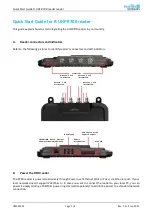
LF1031-INS-LAB-RevD12
16
2. Center the patient over the bed, and rotate the patient to face the foot section of the bed.
SLOWLY release the pressure knob by turning it counter-clockwise for gradual lowering of the
patient (LF1031) or using the hand control pendant (LF1041). Carefully lower the patient onto
the bed. Support the patient’s head, if necessary, while being lowered. Remove the sling by
reversing the procedures used when lifting patient from bed.
Lifting the patient from the floor
1. Position the patient lift behind the patient, placing a pillow over the base to protect and
support the patient’s head and neck. Place the patient's head carefully on the base. The patient
lift should be positioned with the spreader bar centered over the patient.
2. Lower the spreader bar. Attach the sling to the spreader bar hooks.
3. Lift the patient up above the floor. Position the patient in the sling by pulling the handle on the
back of the sling. Turn the patient to face the lifting column, and place the patient’s feet on the
base, straddling the column for extra stability.
Lowering the patient to the floor
1. Place a pillow on the base to protect the patient’s head and neck (this is unnecessary when
using a sling with a head support).
2. Reverse the above procedures to lower.
Transferring the patient from a chair to a wheelchair or commode chair
Info: GF Health Products, Inc. recommends that two attendants be used when transferring a
patient to and from a wheelchair.
1. Fold the sling.
2. While maintaining support, gently lean the patient forward. Place the folded sling behind the
patient’s back and push it down until it touches the seat of the chair.
3. Use the loops to pull the leg sections of the sling forward and beneath the patient’s thighs.
Then cross the loops, one through the other.
4. Move the patient lift around to the front of the chair.
5. Hook all sling loops onto the spreader bar.
6. Carefully raise the patient.
7. The second attendant should now move the wheelchair into position.
8. Engage the wheelchair wheel locks to prevent movement.
WARNING: Before transfer, ensure wheelchair wheel locks are in locked position.
Wheelchair wheel locks must be in a LOCKED POSITION before lowering the patient into
the wheelchair, or unexpected wheelchair movement could result, which may result in
serious personal injury to both the patient and the attendants.
9. Position the patient over the wheelchair with their back against the back of the wheelchair.
10. SLOWLY lower the patient into the wheelchair.
11. With one attendant behind the wheelchair and the other operating the lift, the attendant
behind the chair should pull back on the handle or sides of the sling to place the patient into
the back of the chair. This will maintain a good center of balance and prevent the chair from
tipping forward.













































